For the first in a series, artist, curator, producer, and all-around creative force April Gertler shares her colorful and exuberant style. After a fun show-and-tell (i.e. the photo shoot) at her home in Berlin, we sat in the kitchen and spoke about her personal relationship with clothing and what has shaped her individual style.
How would you describe your personal style?
Eclectic, a little quirky, not really following fashion trends.
Do you feel it reflects who you are as an artist?
Absolutely. I have a habit of not following mainstream trajectories. I’ve very often done things my own way. My parents were both immigrants to the States, and I’m first-generation American. My mom was an incredible resourceful person. She had a very interesting way of approaching things and a very unusual style sense. Everything we had was always secondhand. She would buy our clothes at the secondhand shops for my sister and me. It was difficult because my friends—in a typically American way—would ask, ‘Where does that top come from? That’s really cool.’ I would often lie because it came from the thrift store down the street and that wasn’t cool back then.
So [my style] has always been like that. I have never been one to enjoy shopping. About 10 years ago a friend of mine invited me to a clothing swap—that was life-changing. I loved the idea that I could swap clothes and eventually get them back if I wanted to, because we were and are all close friends. We have created a fantastic network. I bought the sweater I’m wearing [right now] for two euros at a flea market but the pants and the top I swapped. These black earrings were traded for an artwork. That’s what I love to do, trade, swap, and find bargains.
My mom used to say, ‘It’s about creating your own style. Be your own person’. That was her motto for my sister and me as we were growing up. She would say, ‘ I want you to be somebody,’ and I interpreted that to mean that, you have to create yourself. Of course, that not only comes from how you look, what you do, whom you talk to—but a combination of all of these things.
She told my sister and me, that over and over again, which was fantastic. She was a very unusual woman in that way. Quirky.
It sounds like her encouraging you to develop yourself also primed you to know your voice as an artist.
Absolutely. I grew up in an atheist household. Both of my parents were persecuted for their religions—my father is Jewish and my mother was Protestant. She grew up in a Catholic neighborhood, in super Catholic southern Holland. We didn’t celebrate Christmas or any religious holidays whatsoever, partly because my parents couldn’t agree.
I was nine years old when I started really questioning. I was in elementary school and we were saying the pledge of allegiance and one part of the pledge of allegiance is ‘Under God we trust’ and I said, ‘I don’t believe in God so I’m not going to do that. In fact I’m not saying this, I’m sitting down because I don’t agree with this pledge of allegiance.’ So I sat down and was sent to the principal’s office. My mom had to come to school. The principal was adamant, ‘Your daughter was not saying the Pledge of Allegiance.’ She said, ‘Why should she say it? She doesn’t have to say it if she doesn’t want to. It’s true, why are we all talking about God?’ She totally supported me and was on my side. I had to agree to stand up but I never had to say [the pledge] again.
That was my mom: very powerful, very strong person and personality—the Dutch woman. My dad is Hungarian. They were fiery together. My upbringing came from this intense, strong family with a lot of opinions.
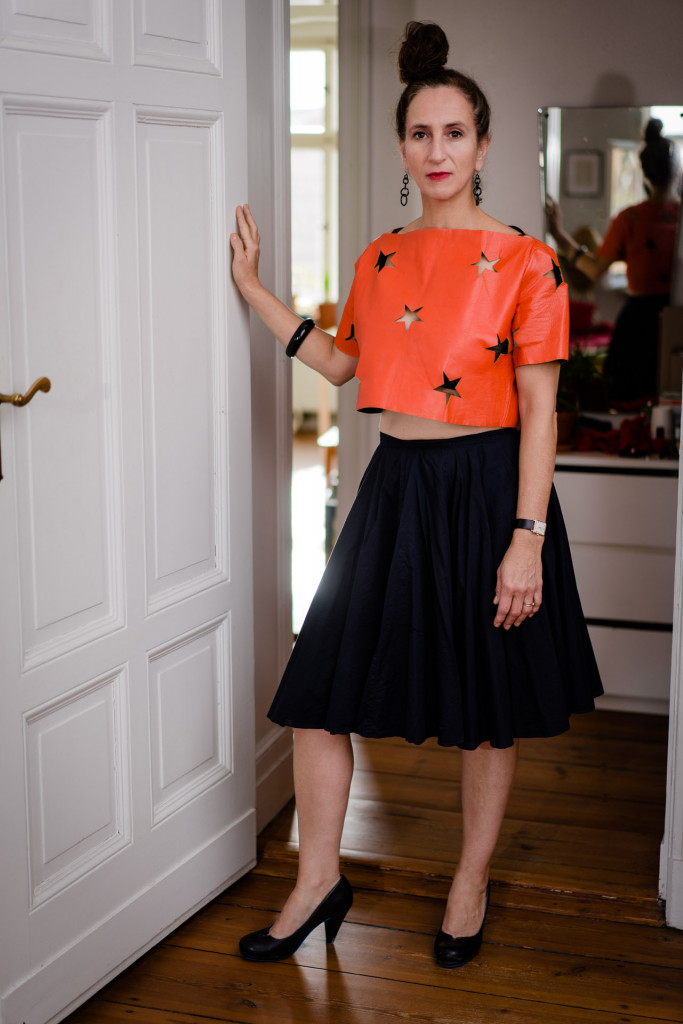
I think my style has been informed by my parents and what the norm was in my family, and what was acceptable. Also, you look to your family to see what they are wearing in terms of fashion and style. I never dyed my hair [crazy colors] but I would wear weird outfits to high school and my mom was always supportive. My dad would always snicker and make obnoxious comments. My mom would often say, ‘Let her do whatever she wants! I think it looks great.’
How did your classmates respond to your outfits? If you had to say the pledge of allegiance, it sounds like it might have been a conservative environment.
It wasn’t necessarily a Republican town but it was quite conservative.
I had friends but there weren’t very many of them. My friends told me that they liked what I was wearing but in retrospect, I was always a bit off the fashion mark. I wanted to be fashionable but my parents wouldn’t support that. I remember wearing a shirt with a logo once. I sat down for breakfast and my dad said, ‘Are they paying you to wear that shirt? Why are you advertising a company for free? That’s ridiculous!’ I realized he was right and that was the last time I wore anything with a logo on it. To this day I do not wear logos. I am much more attracted to clothes that can’t be placed, that you don’t know what they are or where they might come from. I don’t care about high fashion brands; I care if it’s an interesting style, color or pattern. I really love Marimekko or Missoni—I don’t own any from either brand but I appreciate the patterns and styles.
Has your style evolved in your movement from the Bay Area to Germany or over time?
Oh, yes. The most obvious change was moving to Europe because I felt the freedom to wear whatever I wanted. It was such a liberation to not be catcalled or commented on. You know what I’m talking about: a day does not go by in the States that a woman—young or whatever—walking down the street is not commented on. All of a sudden I was wearing things that I would never wear. I would never wear the orange top in the States for example. No way.
A few years ago I went to my hometown and I saw an old friend. We’ve been friends for thirty-something years, since junior high. I was wearing fishnet stockings—I love stockings. I have a lot of colorful stockings, patterned stockings, and crazy weird ones. They are a great accent to an outfit.
I love the length of my white skirt. I was wearing [a similar skirt], a top, flat shoes, and colorful fishnet stockings. My friend said to me, ‘You’re going to wear those stockings?’ ‘Yeah,’ I said, ‘What’s wrong with them?’ ‘They’re fishnets,’ she said. ‘They’re what sex workers wear. You can’t wear those here. You can maybe wear those in Europe but you can’t wear them here.’ I said, ‘ I think they look good.’ ‘I am only going out with you because you are who you are and you’re always like that.’ And that was that — we went out together but I think she was uncomfortable with me. So yes, I guess my hometown is conservative or maybe narrow-minded when it comes to fashion.
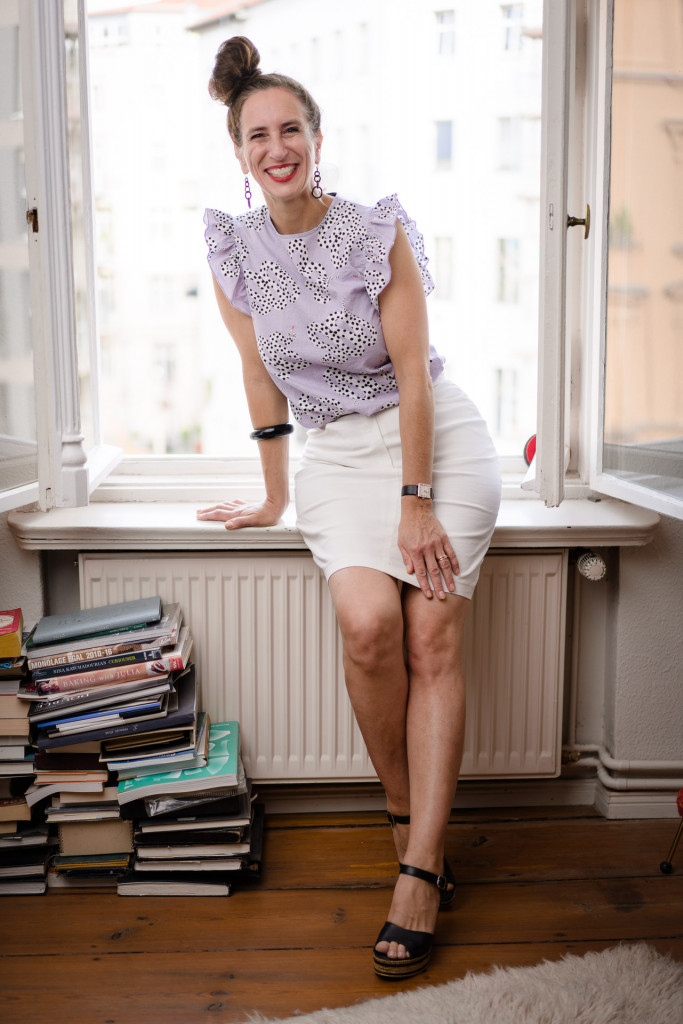
How long have you been living in Germany?
Fifteen years in Berlin. I was in Frankfurt for two years, so I have actually been here [in Germany] for 17 years. It’s really distressing to say that just because It’s been such a long time by now!
Your last book, PUSSYBOW, incorporates some interplay and connection with fashion and beauty images.
Definitely. In my collage work, I am interested in mainstream representation of women, acknowledging that representation and looking at it, not only in magazines, fashion magazines, but also in found images of people. I am interested in women photographing themselves—or being photographed—and the positions they take to present themselves. I am curious about how elements of our bodies are highlighted and why they are highlighted. I focus and look at that in my collage work. Sometimes it’s about what they are wearing; sometimes it’s about their face or hair. There are many different things that trigger me.
I work with thread a lot; it’s like a pencil or a pen for me. It is a way to make a line that has more of an impact for me than a line drawn on a piece of paper. I like the tactility and that it stands up slightly from the page. That’s why I use thread a lot.
I am really interested in fashion in this way: why women are presented and present themselves the way they are and do and how we are manipulated to think that these styles and ways of being in the world are the right way or are what is beautiful. Now that I have turned 50, I am reevaluating. I’ve always felt a bit weird in what I wear because I’m not really on trend. But you know what, now it’s my style and it’s who I am. I’m pleased that I don’t follow fashion norms and I make an effort to dress up in my way and be fashionable in my way. I feel good about that.
My friends and I all do this. We all are committed to looking good; we think that’s really important. It’s a topic we talk about a lot. I used to follow the Sartorialist, but then I saw him speak in Berlin and was disgusted. He looked around at the audience that evening and said to us, ‘There is obviously no style in this city.’ I thought: Fuck you. That is so obnoxious. Who do you think you are? You are one person. You are not looking; in fact you are not [grasping] German style. Because German style, Berlin style is subtle. It is very discreet. That is the German mentality as well, extremely discreet. To not understand that and make a blanket statement like that—you haven’t even tried.
That pissed me off. I’m not interested in that way of being and that focus.
Advanced Style is a blog I really love. The women photographed in that blog are at times much older than me. What is interesting—and not talked about enough—is that when someone is passionate and is full on doing their thing, your opinion about their style, their approach, or what they’re focusing on is irrelevant. The fact is these people have made a dedicated attempt to be in themselves and are fully committed to who they are—and that is respectable. That’s what I love about that blog. I don’t always agree with the look—and it is so irrelevant what my opinion is—but I love that these people are full on themselves. That’s what I want to embrace more. I just want to be more me, more myself, because that’s what people respond to.
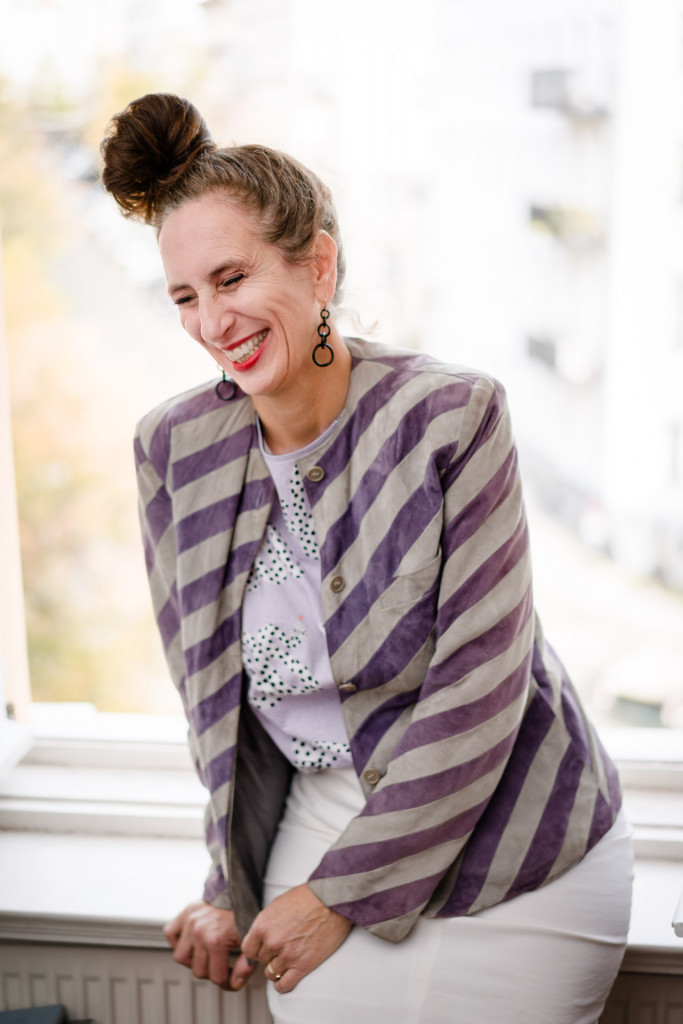
That authenticity is something we’re missing more and more these days. Regarding your work and how you touch on this, has your work has changed in Berlin?
Yes, my work changed. Ten years ago I made a conscious choice to stop chasing curators and galleries to show my work. I still show my work but it’s more on my own terms. That’s a goal for most artists: they want to live from their work. What is essential for me is that everything I do is about my artistic practice: the clothes I wear, what I eat, the way I live. I feel all of these things are interconnected. It is very much about living a creative life in addition to being an artist for me so I made a conscious effort to integrate those worlds.
I’m reminded of your mom saying: ‘You have to figure out your vision and how you present yourself,’ and how you present your work. It’s all connected.
Yes, for sure. She was very instrumental in that although she couldn’t understand the choices I was making and why I was going to art school. She would tell people I was going to a vocational school because she couldn’t understand what I was doing.
What has predominantly changed in terms of my work and having a holistic approach to my whole life is moving much more in the realm of social practice as a methodology and medium of working. SONNTAG is a project I do with my partner where we invite an artist to show their work and make their favorite cake. It’s very much about creating an experience. I started IN SEARCH OF THE MIRACULOUS six years ago for the incoming residents of PICTURE BERLIN—it is a walking experience. I invite five to six other artists to work with me and set the parameters. They create walks in the neighborhood of their choice and talk about what they want to but there are a few things I want them to include, practicalities like a resting spot and a snack or a drink. These elements should conceptually connect to what they talk about.
The walks are so fantastic, varied, and deep in terms of space. You see places and you are exhausted or jet lagged; sometimes it’s a dream and sometimes it’s not. I love all of those external elements. That practice or project has fed into TAKE THE CAKE, a performative baking experience. SONNTAG is a social experience and once in a while we do a pop-up bar at tête, which is another experiential practice. I have a lot of ongoing projects. Many of them happen once in a while and involve other artists and are about creating an experience for other people. Out of that comes dialogue, exchange, and memory. The work is then a memory and that memory is shared. How it is shared is also fascinating.
That reminds me of the clothing swap with your friends and how you tell a story about each piece.
We take turns: one person presents every element they brought and shares a short story or remark. It could be as simple as: ‘This is a size 38. These shoes are size 41.’ We have a core group but those people also do swaps so it extends out. One woman doesn’t come very often because she is a friend of a friend. Once she said, ‘Okay, here is this top. I’m not really sure about it. The main problem with this top is that every time I put it on, it makes me want to suck my thumb.’ We all fell over laughing and then we started feeling it. We all tried it on because we were curious. She was right. How could a fabric do that? But it did, it was so fascinating.
How would you describe the fabric?
Well, it was kind of a satin-y soft, like a baby blanket. It had a coolness to it but it was really soft.
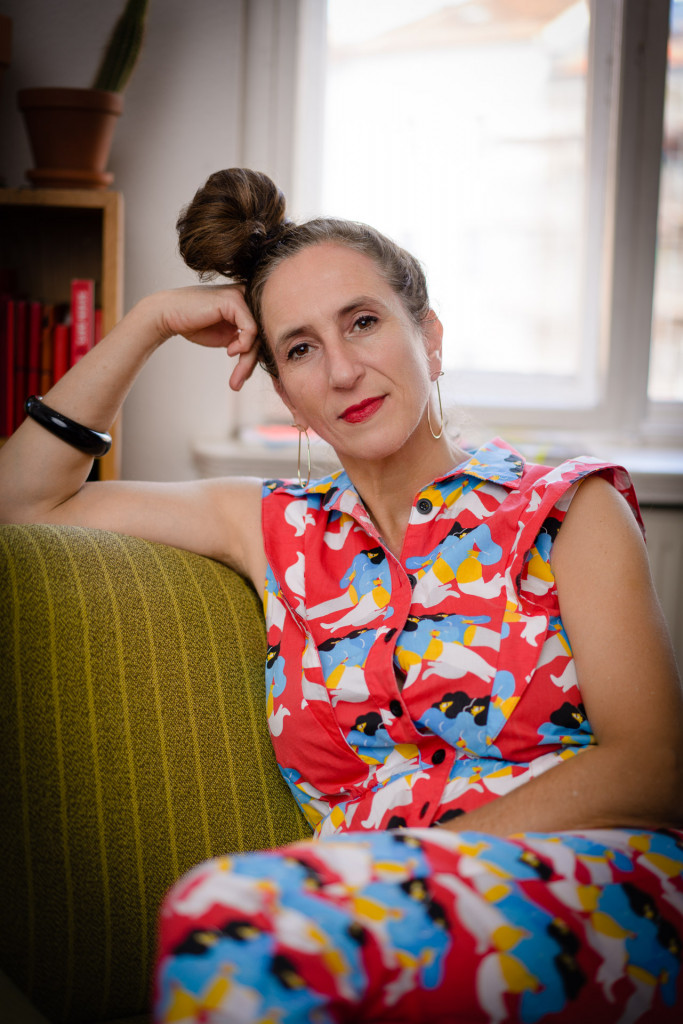
Did someone take it home?
Yes, someone took it. Stories like that stick with you and again, it’s an experience. It’s not like, ‘I’m giving you this shirt because I don’t want to wear it anymore.’ It’s more like, ‘This is my story with this item.’ Also, people are attracted to certain kinds of clothing. We become a clothing critique group: ‘Overwhelmingly yes, you need to take it’ or ‘No, it doesn’t look good on you.’ Some people try to help the other person or say, ‘Well, if you tighten it here, or tuck it in there, or wear it like that,’ and then the others will say, ‘No, that doesn’t work. Maybe Emily should try that top on because it might look better on her.’ You try it on and ‘Oh yes, it looks much better on Emily.’ But it’s not personal. It’s a color thing, a fabric thing, a size thing, but we’re really supporting each other. We are encouraging each other to look the best we can.
I love that support and experience. We are here, we are women, and we are doing this with each other. I think women can be catty and evil with each other so I find the atmosphere that is created really lovely. We always bring wine and have food, and it goes for hours, at least five hours.
We’ve gotten to the point now since we’ve done it for so many years that if one of us isn’t there, we’ll say, ‘Let’s save that one for Lise because we know she will love this and it will look great on her.’ That’s really nice.
One of the outfits you wore is a very special one, for your 50th birthday. Can you tell me about it?
I have been gearing up to wear only jumpsuits because jumpsuits have pockets. A lot of women’s clothing doesn’t have pockets as all women know. Jumpsuits are incredible—it is a whole outfit all in one and you don’t have to think about it. It’s comfortable and flexible and easy.
That jumpsuit is very special; it’s very colorful and pretty outrageous. It’s from Nooworks, a women-owned company in San Francisco. They invite artists to make fabrics. They have a line of designs that they use over and over again but they use the artists’ fabrics to recreate the line. I love that concept. I love how wild and out there the patterns are.
And it ties into everything you do. Did you pick up that jumpsuit in person?
I bought the black corduroy version of it in the shop so I knew my size. It’s my sister’s favorite shop and we always go there when I visit her. I wanted to have something special for my birthday and thought: ‘I’m going to splurge and get a fancy jumpsuit.’ I know that style works well for me. I like the [ruffle] kind of wings and the buttons down the front. I am debating which one to get next. I want to just have a closet of jumpsuits.
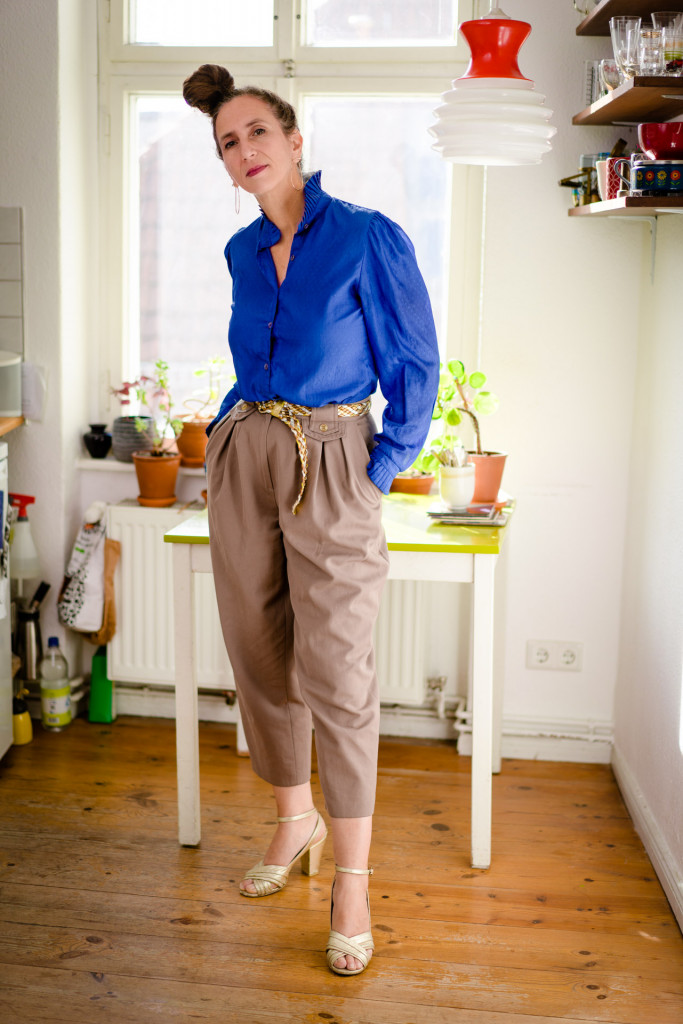
That jumpsuit is very special; it’s very colorful and pretty outrageous. It’s from Nooworks, a women-owned company in San Francisco. They invite artists to make fabrics. They have a line of designs that they use over and over again but they use the artists’ fabrics to recreate the line. I love that concept. I love how wild and out there the patterns are.
And it ties into everything you do. Did you pick up that jumpsuit in person?
I bought the black corduroy version of it in the shop so I knew my size. It’s my sister’s favorite shop and we always go there when I visit her. I wanted to have something special for my birthday and thought: ‘I’m going to splurge and get a fancy jumpsuit.’ I know that style works well for me. I like the [ruffle] kind of wings and the buttons down the front. I am debating which one to get next. I want to just have a closet of jumpsuits.
The lilac blouse is also from Nooworks. I love shoulder details, [just] like the blue 1980’s blouse I wore. A friend of mine wears stuff like that and I got really into it too. I love the way the shoulder ruffle stands up [on the lilac blouse]. Sometimes I think, ‘Is this really age appropriate?’ But I don’t know and I don’t care.
What does that even mean?
I don’t even know what that means but it is something that creeps into my head sometimes.
Take that voice and throw it away!
But you see: I’m still dealing with this stuff. I think we all are.
Yes. Can you imagine if we were in the US? It would be oppressive.
Phenomenally oppressive.
There is a lot of power in changing the silhouette and taking up more space with something like shoulder details. Plus, they frame the face, like earrings do. You have a collection of earrings…
Yes, I have earrings and jewelry and stuff—I love accessories.
Are there certain items that you don’t leave the house without, like wearing lipstick or earrings?
Yes! I always wear lipstick. I love wearing earrings, I always have. I love rings, though I’m not wearing a lot [right now]. I usually paint my nails so they are colorful too. The nail polish then becomes an accessory as well.
All photos by Bernd Ott.
For those of you in Amsterdam, April is performing TAKE THE CAKE: APPELTAART on Tuesday, January 21 at 18h. She will also be launching her book TAART TALK, a collection of Appeltaart recipes at the event!
De Bouwput
Ferdinand Huyckstraat 74
Amsterdam, Netherlands 1061HW


0 thoughts on “Style Sustained: April Gertler”